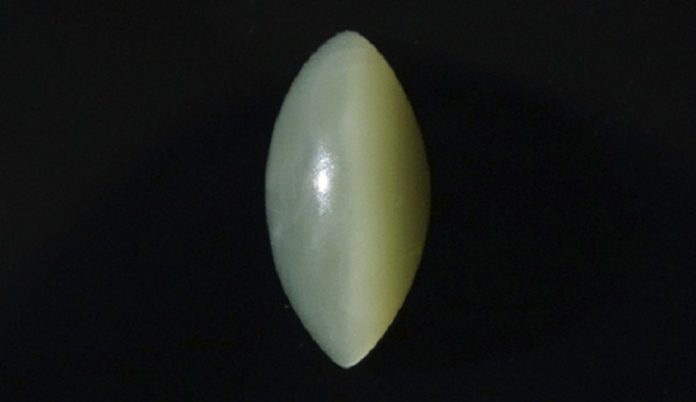Washington Jade (Edmonds, Washington) made its Tucson debut at the AGTA show with nephrite jade from Washington State. They offered a selection of cabochons with and without chatoyancy, along with carvings and rough collectors’ stones. The cat’s-eye nephrite (figure 1) was the most popular by a wide margin, according to Washington Jade’s Nathaniel Cook. Rod Cook, his father and business partner, said that according to many at the show the chatoyancy was reminiscent of the Siberian nephrite that dominates the mid- to high-end Chinese nephrite market.
Cat’s-eye nephrite is found only in Washington and Russia; a deposit in Taiwan has been mostly depleted. While nephrite has been found in northwest Washington since the early 1900s, formal production was limited to an operation west of Darrington, near Everett, that ended in the 1970s. Chatoyant nephrite was documented there in 1974. Since then there has been an artisanal “gray market” for nephrite, with people collecting illegally from streams and state lands, but no formal production. This changed in 2012 when Washington Jade began staking claims. Most of their production comes from a deposit northwest of Darrington.
Washington Jade uses innovative small-footprint mining methods instead of more invasive traditional methods. To identify a jade seam, they use pattern recognition to look at geologic models of the area, along with biological indicators such as tree species and lichen growth. Magnetic and conductivity surveys are used to locate the high-grade portion of the seam. With these methods they can develop a 3D model of the subsurface and focus on the high-grade deposits, in contrast to the traditional model of core drilling, digging up an area with heavy equipment, and taking out all the jade to be sorted by grade. They take only the high-value materials, leaving the rest in the ground. Rod Cook said they backfill and replace the plants after extracting the jade, leaving a very small footprint.
British Columbia is the leading supplier of nephrite, but Washington’s deposits, part of the same geological formation, have yet to be developed. The domestic jade market is much smaller than the Asian market, where jade has been part of Chinese culture for thousands of years. Nathaniel Cook said the nephrite market overall has tightened recently and prices have come down after steady growth the past two decades, but people were still surprised by what they saw as a low price point for the cat’s-eye material.
Rod Cook said there has been an explosion of artisanal jewelers using nephrite. The cat’s-eye nephrite is popular with them, though market acceptance is still in the early stage. He noted that Washington Jade’s output is large enough to meet domestic demand and could be scaled up to the level needed for a jeweler with a few hundred stores. He sees a trend toward jewelry with “less bling” and said that millennials seem to prefer carved material over faceted.
The Cooks also discovered a “jade cave” (figure 2) in a 200-foot canyon cut by a stream. The jade exposed there informs their geologic models by allowing them to see what a similar structure looks like deep in the ground. The cave formed when a piece of the main chatoyant seam broke loose, slid down the hill, and fell into the stream along one side, creating a tunnel underneath. During the spring melt, water flowed through and created a hydraulic plume, which washed away the overburden on one side and revealed a 2-foot-wide seam of chatoyant jade traveling up into the mountains. Rod Cook estimates there are 30 to 100 tons of chatoyant jade in the cave’s immediate vicinity, and they have confirmed outcrops of the main nephrite lode containing the chatoyant seam for 1,500 feet over two of their 23 claims. Based on their discoveries so far, he estimates that the main lode is 150 to 300 feet wide and “goes for miles.”
New Source : gia.edu
Disclaimer: This information has been collected through secondary research and TJM Media Pvt Ltd. is not responsible for any errors in the same.




























